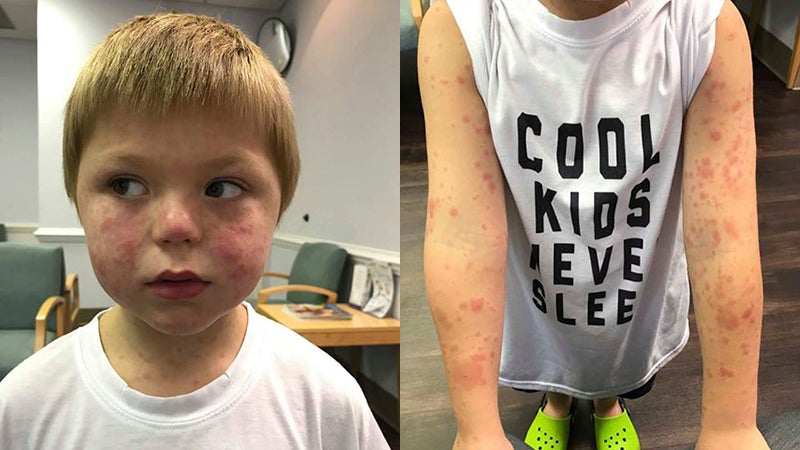LaGrange mom raising awareness for Rocky Mountain Spotted Fever
Published 3:51 pm Wednesday, June 6, 2018

- Mason McNair, 5, has fully recovered from Rocky Mountain Spotted Fever. --Contributed Photos
A local parent is trying to raise awareness for a rare condition after her 5-year-old son was recently diagnosed with Rocky Mountain Spotted Fever.
LaGrange resident Danielle McNair said her son, Mason, had a tick in his belly button on May 10. The tick was discovered while he was at his grandparent’s house, which is near the Alabama line in Troup County, but they were unsure how long it had been there.
Doctors prescribed an antibiotic, but Mason wasn’t feeling better. He had diarrhea, headaches and abdominal pain, symptoms doctors said were all attributable to the antibiotic he was on.
On the final day of the antibiotic, Mason was outside playing when he broke out in a rash that went all over his body.
“At first, it looked like a heat rash because we were outside playing,” McNair said. “That’s when we went back to the doctor.”
McNair said doctors told her again that the rash was likely a side effect of the antibiotics, but she wasn’t satisfied with that. McNair did her own research, and received some assistance from her sister, Marlaina Nelson, who is a veterinarian. Together they determined that all of Mason’s symptoms were attributable to Rocky Mountain Spotted Fever, a rare condition spread by ticks.
On May 21 — 11 days after Mason’s tick was discovered — McNair asked doctors to run tests to determine if her son’s illness was from the tick bite, and tests came back positive for RMSF.
“Rocky Mountain Spotted Fever can be fatal if it’s not treated,” she said. “If I hadn’t done that, we would be in a completely different situation right now, so I’m glad I did my own research.”
Throughout the process, McNair said the doctors who saw Mason didn’t spend much time considering the tick bite for his symptoms. However, she isn’t blaming any doctors or anyone in the medical community for the slow diagnosis. She said she understands the low chance of a RMSF diagnosis, which is why she’s trying to spread the word to other parents.
She posted Mason’s story on Facebook, and it has been shared more than 250 times.
“I want to empower parents to always be an advocate for their child and to always research on their own, trust their instincts,” McNair said. “Even if a doctor or many doctors try to disregard your concerns or try to push them to the backburner, or make you question what you know is wrong, always speak up and don’t give up. Keep on pushing until your satisfied and your kid is healthy.”
Hayla Folden, Public Information Officer for District 4 of the Georgia Department of Public Health, said the number of local cases of Rocky Mountain Spotted Fever are usually low. There were 23 cases in the 12-county area that District 4 covers in 2017, but the numbers vary. There were 14 cases in 2016, 30 in 2015, 7 in 2014 and 15 in 2013, Folden said.
According to the Center for Disease Control, tickborne spotted fevers, which includes RMSF, may cause more than 3,000 cases per year in the continental United States. The CDC also says more than 60 percent of cases occur in five states — North Carolina, Tennessee, Oklahoma, Arkansas and Missouri.
The signs and symptoms include fever, headache, rash, nausea and vomiting, stomach pain, muscle pain and lack of appetite.
Many of the early symptoms of RMSF are common to many illnesses, but the rash usually occurs between two and five days. In Mason’s case, McNair said the first set of antibiotics may have delayed the rash.
The CDC website says that if it is not treated correctly, death can occur within eight days of symptoms starting.
Folden said the Georgia Department of Public Health recommends treating ticks and mosquitoes the same way — avoid the bite.
“Your best bet is to prevent a bite, using EPA approved insect repellent and using it correctly anytime you are outside walking in bushy, grassy areas,” Folden said. “We want to prevent those tick bites.”
Folden also said when you get inside check for ticks on your body and clothes. Pets also commonly carry ticks and should be checked frequently.
Folden said if you find a tick on your body, use fine-tipped tweezers to grasp the tick as close to the skin surface as possible and pull straight up with steady, even pressure. She said if the head area stays on, continue to remove with tweezers, and then clean the bite area with rubbing alcohol or soap and water.




